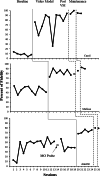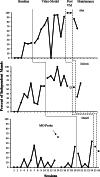POWER: A Caregiver Implemented Mand Training Intervention
- PMID: 36457834
- PMCID: PMC9582187
- DOI: 10.1007/s40617-021-00620-5
POWER: A Caregiver Implemented Mand Training Intervention
Erratum in
-
Correction to: POWER: A Caregiver Implemented Mand Training Intervention.Behav Anal Pract. 2021 Jul 30;15(3):714. doi: 10.1007/s40617-021-00637-w. eCollection 2022 Sep. Behav Anal Pract. 2021. PMID: 36459155 Free PMC article.
Abstract
The development of a vocal mand repertoire is often delayed or deficient in children with an autism spectrum disorder. Utilizing caregivers as behavior change agents to address this core deficit may be advantageous as more learning opportunities can be incorporated in daily routines. A plethora of literature exists on teaching caregivers to promote communication with their children; however, many of these studies use behavioral skills training that can be resource-intensive. This study evaluated the effectiveness of video modeling with voice-over and on-screen text, without researcher mediation, as an alternative to behavioral skills training for teaching caregivers to teach vocal mands to their 2- to 5-year-old children with an autism spectrum disorder. The video model described mand training with an echoic prompt (Greer & Ross, 2008; Kodak & Clements, 2009), using a mnemonic (POWER: Play, Offer, Wait, Encourage, and Reinforce). Results of our nonconcurrent multiple baseline design across three dyads indicates that video modeling was effective in increasing all three caregivers' mand training fidelity, and this correlated to small increases in independent mands with some of the child participants when training occurred less than 1 hr per week. We discuss implications for practice and areas for future research.
Keywords: caregiver implementation; mand training; video modeling.
© Association for Behavior Analysis International 2021, corrected publication 2021.
Conflict of interest statement
Conflicts of interest/Competing interestsThe authors declare no conflicts of interest.
Figures
Similar articles
-
Teaching caregivers to implement mand training using speech generating devices.J Appl Behav Anal. 2020 Apr;53(2):1097-1110. doi: 10.1002/jaba.630. Epub 2019 Sep 2. J Appl Behav Anal. 2020. PMID: 31478192
-
Caregivers as Interventionists and Trainers: Teaching Mands to Children with Developmental Disabilities.Anal Verbal Behav. 2014 Apr 26;30(2):128-40. doi: 10.1007/s40616-014-0005-z. eCollection 2014 Oct. Anal Verbal Behav. 2014. PMID: 27274975 Free PMC article.
-
Evaluation of a vocal mand assessment and vocal mand training procedures.J Appl Behav Anal. 2004 Summer;37(2):129-43; quiz 143-4. doi: 10.1901/jaba.2004.37-129. J Appl Behav Anal. 2004. PMID: 15293633 Free PMC article.
-
Communication in young children with motor impairments: teaching caregivers to teach.Semin Speech Lang. 2006 Aug;27(3):199-214. doi: 10.1055/s-2006-948230. Semin Speech Lang. 2006. PMID: 16941290 Review.
-
Advances in Supporting Parents in Interventions for Autism Spectrum Disorder.Pediatr Clin North Am. 2022 Aug;69(4):645-656. doi: 10.1016/j.pcl.2022.04.002. Pediatr Clin North Am. 2022. PMID: 35934491 Free PMC article. Review.
References
-
- American Psychiatric Association. (2015). The diagnostic and statistical manual of mental disorders (5th ed.). Washington, DC: Author.
-
- Virués-Ortega, J. (2010). Applied behavior analytic intervention for autism in early childhood: Meta-analysis, meta-regression and dose–response meta-analysis of multiple outcomes. Clinical Psychology Review, 30(4), 387–399. 10.1016/j.cpr.2010.01.008 - PubMed
-
- Ayres, K. M., & Langone, J. (2005). Intervention and instruction with video for students with autism: A review of the literature. Education & Training in Developmental Disabilities, 40(2), 183–196.
-
- Barton, E. E., & Fettig, A. (2013). Parent-implemented interventions for young children with disabilities: A review of fidelity features. Journal of Early Intervention, 35(2), 194–219. 10.1177/1053815113504625.
LinkOut - more resources
Full Text Sources



